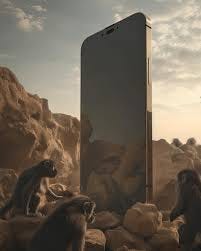Apple’s 1984 advertisement presaged its ironic trajectory—from smashing Big Brother to owning the most closed system in tech
Greetings adventurer!
Our quest begins in the Tower, where the sorcerers of Silicon Valley shape our habits from far above.
A stone stairwell beckons. Lights flicker overhead. Let’s push forward.
The idea that technology has irrevocably altered our lives—that something changed with the rise of the smartphone in particular—is hardly breaking news.
We’ve been feeling it for over a decade now.
It seems like every year a new book uncovers another facet of the deepening tech addiction/attention crisis; notable titles include:
Dopamine Nation by Anna Lembke (2021) — an addiction expert explains our increasingly complicated relationship to pleasure: “How do I live in a world in which everything is provided?”
Stolen Focus: Why You Can’t Pay Attention by Johaan Hari (2022) — a deep dive into how our attention has been commandeered by powerful systemic forces
The Internet Con: How to Seize the Means of Computation by Cory Doctorow (2023) — a theory of internet enshittification and a call-to-action to change it
The Anxious Generation by Jonathan Haidt (2024) — a comprehensive survey of the devastating effects of smartphones on adolescents and teens
These are all excellent reads. I’ll pull from their best insights. But let’s be honest: the conversation around technology addiction feels a little tired.
We know we shouldn’t sleep with our phones. We know refreshing our email every five minutes is dumb. We know checking our texts at the dinner table disengages us from our loved ones. And yet we do it anyway.
So yes, we are collectively hooked, entranced, enchanted. No one needs convincing on this point. But it’s worth exploring exactly how our minds have been captured. What is the nature of our collective hypnosis? And why can’t we break out of it?
Let’s call it The Spell.
In this three-part Questline, we’ll first explore what the Spell is, and then decide—together—how to combat it.
What Is The Spell?
The philosopher Slavoj Žižek has a great take on ideology. The old definition, he says, was: “They do not know it, but they are doing it.”
Today, in Žižek’s estimation, ideology means something different: “They know it, but they still do it.”
That’s exactly how the Spell works.
Reaching for your phone the second boredom creeps in. Opening [Reddit], [Instagram], [Facebook], [TikTok]. Refreshing, refreshing.
Refreshing.
Refresh—
The Spell is the cumulative effect of a thousand small design choices, all working in aggregate to keep you engaged with what is essentially an advertising and data-capture apparatus living in your pocket. It empowers “users” as it entraps them, offering an endless stream of text, video, and images in exchange for constant, feverish participation.
A proper analysis of the Spell in all its seductive glory would touch on the Protestant work ethic, gossip, information theory, the psychology of addiction, the history of propaganda, the neuroscience of habit formation, and the economics of the attention economy.
We’ll narrow our focus to a few of its most potent aspects. To start with, the Spell commands our thumbs.
Pull to Refresh
Behind all of our check-check-checking is elegant design. One mechanic, in particular, looms over this cycle of repetition and reward.
The “pull-to-refresh” gesture was created by software developer Loren Brichter in 2009. First used in Twitter feeds, the gesture is now pervasive in smartphone apps; it’s as simple as it is addictive: pull down on the screen, wait for the buffering circle, and see what content awaits.
Pull to refresh
Tristan Harris, a Google employee turned industry critic, sums up the experience of pull-to-refresh: “Each time you’re swiping down, it’s like a slot machine. You don’t know what’s coming next. Sometimes it’s a beautiful photo. Sometimes it’s just an ad.”
According to Brichter himself, the pull-to-refresh gesture is far from necessary. An application can update its content without a user “pulling” anything, as many apps do; pull-to-refresh “could easily retire,” Brichter says. But the slot machine effect—pull, wait, reward—is satisfying.
Brichter has his regrets: “Smartphones are useful tools,” he says. “But they’re addictive. Pull-to-refresh is addictive. Twitter is addictive. These are not good things. When I was working on them, it was not something I was mature enough to think about. I’m not saying I’m mature now, but I’m a little bit more mature, and I regret the downsides.”
(Here’s a mini Quest for you: count how many times you engage with “pull-to-refresh” over the course of a day. You will be shocked.)
Closely related to pull-to-refresh is another now-ubiquitous feature: vertical—or infinite—scrolling.
Vertical Scrolling
Before smartphones, reading had stopping points. Books had chapters. Magazines had pages. TV shows had episode breaks.
Now? There’s no stopping point. Ever.
Aza Raskin, a UX designer, invented infinite scroll in 2006. He, too, is very sorry about it:
“I regret that I didn’t think more about how this thing would be used,” he told The Times. He compares the feature to a study in 2005 that gave users bowls of soups that constantly refilled via a tube underneath the bowl. Participants ate 70 per cent more soup than those with normal bowls and did not even notice.
“I know as a designer that by taking away the stopping cue, I can make you do what I want you to do,” Mr Raskin, a former head of user design at the browser Mozilla, said.
Vertical, infinite scrolling is now standard on every major social platform: Facebook, Instagram, Twitter, TikTok, YouTube Shorts. It effectively curtails decision-making, keeping you in motion until something external forces you to stop. Similar mechanics—all aimed at maintaining our attention—have proliferated: Autoplay, algorithmic recommendations, and countdown timers.
Autoplay + countdown timer
The behavioristic brilliance of these features aligns with Johann Hari’s central argument in Stolen Focus: Why You Can’t Pay Attention — that our attention crisis isn’t merely about personal willpower, but about deliberate design choices shaping our information environment. As Hari put it in a recent interview, “Attention is your superpower, and at the moment we are surrounded by Kryptonite.”
What’s worse, the Kryptonite is beautiful to look at, easy to use, and always with us.
Like water to the fish, the Spell renders itself practically invisible.
The Apple Aesthetic and Walled Gardens
It’s easy now to overlook the elegance of an iPhone, a MacBook Pro, or a flatscreen television. We’ve grown accustomed to the beauty of it all — to the frictionless glass surfaces that surround us.
Apple led us here. The clean minimalism of the company’s creations became the template for how we interact with devices: seamlessly, effortlessly. Marshall McLuhan famously said that “the medium is the message.” Apple makes things that look so good and work so well that they disappear. We, in turn, are spellbound.
The iPhone as monolith
So if Apple has set the defining aesthetic of our time—the way oil paintings defined the Renaissance, or classical music shaped the 19th century—what did they do once we were all justifiably enamored with their beautiful things and spaces?
They locked us in.
A “walled garden” refers to a closed digital ecosystem where a company controls what users can access, how they interact, and how content is distributed. Instead of an open internet where you can freely navigate between sites and services, walled gardens keep users inside a single platform, limiting their ability to leave or engage with outside content.
Apple is the world’s greatest walled gardener. iPhones work best with iMessage, iCloud, and AirPods, making it inconvenient to switch to another brand. Apple’s MFi (Made for iPhone) certification means third-party accessory makers must get Apple’s approval (and pay licensing fees) just to make things like charging cables and headphones.
The App Store is one of the most tightly controlled walled gardens in existence. Apple takes a 30% cut from most app purchases and in-app transactions, a rate that has sparked backlash from developers who argue it’s an unfair tax on their businesses.
Apple also edges out competition by limiting third-party access. Unlike Android, which allows users to install apps from different sources, Apple forbids sideloading—meaning you can’t download apps from anywhere except the App Store unless you go through a complicated jailbreak process. This forces developers to comply with Apple’s rules or lose access to a billion iPhone users.
Here, again, is the Spell at work. Once you’re in the garden, it’s incredibly difficult to leave. And why would you want to? It’s amazing, after all.
Come on—just a little farther to go, and then you have a choice to make.
Finding Moral Ground
In The Society of the Spectacle, Guy Debord writes:
The spectacle is not a collection of images, but a social relation among people, mediated by images.
You might need to read that twice to let it sink in. Debord wrote those words in 1967. More than fifty years later, I can’t think of a better summation of contemporary culture.
We aren’t addicted to our devices for no reason. They are a means to other people. They are conduits for love, desire, work, purpose. This is why we need to be precise when navigating these debates and thinking about the Spell.
On the one hand, the same forces that fragment adult attention are now shaping childhood itself. In The Anxious Generation, Jonathan Haidt writes:
Gen Z became the first generation in history to go through puberty with a portal in their pockets that called them away from the people nearby and into an alternative universe that was exciting, addictive, unstable, and—as I will show—unsuitable for children and adolescents.
Imagine yourself at seventeen (or seven) years old under the influence of infinite scrolling. This is clearly too much power, too soon. Right?
On the other hand, there’s no undoing this, there’s no hard counter for the Spell. Look at the Luddites, who smashed textile machines in opposition to industrialization. Or the early critics of automobiles, who warned that cars would get people killed, erode communities, and reshape the country. They were absolutely right. Their backyards became parking lots.
And I mean really, ask yourself: on what moral ground do we claim that a kid with an iPhone is good or bad? Before smartphones, it was television, radio, newspapers. What’s wrong with imbibing information? Who says?
We’re lost in the desert of moral relativism, where the sand is shifting and firm footing is impossible. Alasdair MacIntyre wrote about the sheer irrationality of our moral discourse in After Virtue. He argued that without a shared moral framework, ethical debates become little more than competing emotions—loud opinions with no agreed-upon foundation.
Suffice to say, we must find more coherent ways to agree on what’s right and what’s wrong. Nothing is more important.
As far as the Spell goes, that means carving out a fairly nuanced position and then getting fired up about it. This is a challenge. A lot of smart people—some technologists included—are working on it.
It’s a lot easier to be passionate about an extreme position — to make signs, and yell at people. Occupying the middle ground requires parsing what’s happened and what will happen. It requires reminding yourself of what you believe and why.
So with that, it’s decision time, my fellow adventurers.
The stairwell stretches endlessly upward, but a window offers an escape—a rope dangling just below.
Do we remain in the Tower, investigating next-generation algorithmic wizardry and UX design? Do we meet the people fighting back, working to fix technology with technology? Do we explore collective, societal, and corporate-level solutions to the Spell?
Or—
Do we rappel down and journey to the Fountain, the wellspring of self-optimization, and figure out what you can do right now to resist The Spell? Do we talk about slow tech, phone jails, getting back to nature, digital Sabbaths? Do we revisit thinkers like Henry David Thoreau, Wendell Berry, and explore the wisdom of stepping away?
Collective, tech-powered action vs individual, self-modifying change.
The choice is yours.
Cast your vote over the next three days, and the winning choice will determine Part 2 of this Quest.
Debate in the comments below, make your vote, and engage @ the Quests community.
More Recommended Reading:
The Age of Surveillance Capitalism
Irresistible: The Rise of Addictive Technology and the Business of Keeping Us Hooked
Ten Arguments for Deleting Your Social Media Accounts Right Now














I held out for a really long time before getting a smartphone when I was in college and I remember feeling like I was the only intelligent person in the room sometimes. They would all be glued to their phones and I remember the feeling of pure annoyance that they were staring at those things...again. I obviously now have a smart phone, but I think about this a lot now that I have small kids. I hate when I find myself scrolling when I should be interacting with my boys. I for sure want to do better.
Reminds me of doomscrolling— something people talk about a lot on tiktok